Snatch High Pull: Technique, Benefits & Common Mistakes
Author:
Reviewed by:
(21 years of Oly Lifting experience)
Unlock your full potential by engaging with our experts and community! Have questions about your fitness journey or looking for expert advice on weightlifting techniques? Don’t hesitate — leave a comment below and Jacek Szymanowski will provide a personalized answer and insights to help you reach your goals.
Torokhtiy is reader-supported. Some links are affiliate links, and we may earn a commission at no extra cost to you. See our disclosure page for details.
The snatch high pull is one of the Olympic weightlifting assistance exercises. Its structure is quite similar to the basic snatch pull but at the same time, it provides plenty of additional load for the upper limb muscles.
There are also some variations of high snatch pull. Let’s find out why weightlifters, fitness, and other athletes should put this exercise on their training plan.
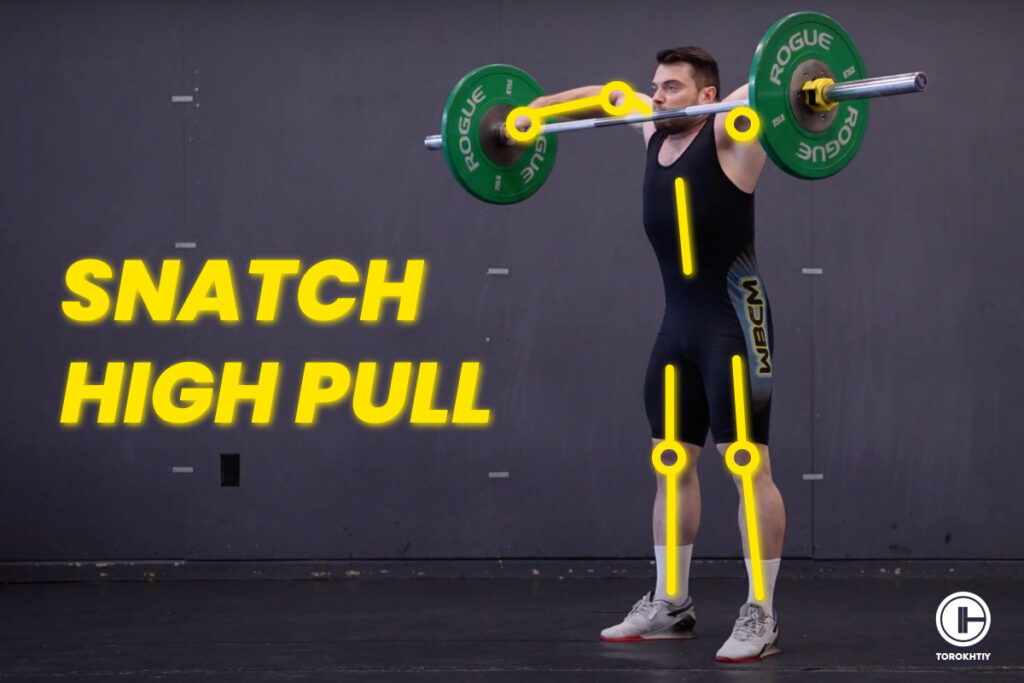
What Is Snatch High Pull?
The snatch high pull is a weightlifting exercise that focuses on developing explosive power and strength, especially in the muscles involved in the snatch lift. It involves pulling a loaded barbell from the floor or hang position up to chest height while maintaining a strong, controlled posture.
The main purpose of the snatch high pull is to improve your ability to generate force through your legs, hips, and upper body, which translated directly into a more powerful and effective snatch. It’s an important exercise for improving your overall lifting technique and performance in Olympic weightlifting.
How to Do the Snatch High Pull?
Now let’s see how to do it!
1. Setup
Start in a standard starting positon, with your feet shoulder-width apart and the bar close to your shins. Grip the bar with a snatch-width grip and keep your shoulders over it. Engage your core, keep your back straight and chest up.
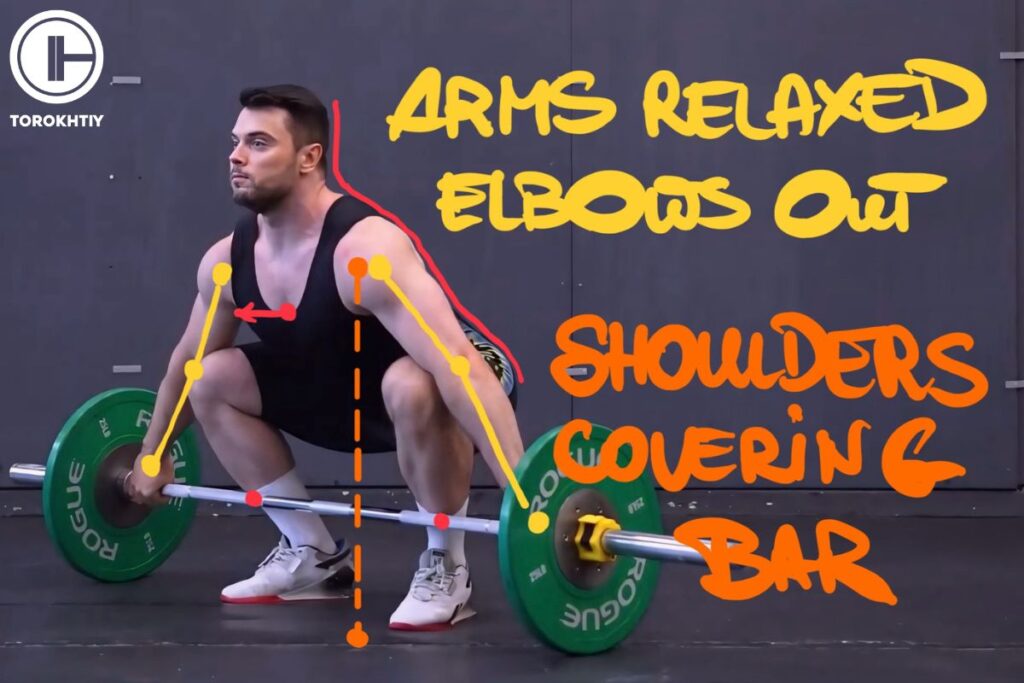
2. First Pull
Extend your legs and lift the bar off the floor. As you lift, make sure that your balance stays in the middle of your feet and that your shoulders stay over the bar. This phase should be controlled and steady .
3. Second Pull
As the bar passes your knees, start to speed up. Keep the bar as close to your body as possible and allow it to lightly brush against your legs. Continue to drive through the legs and hips. Your goal is to generate maximum power during this phase.
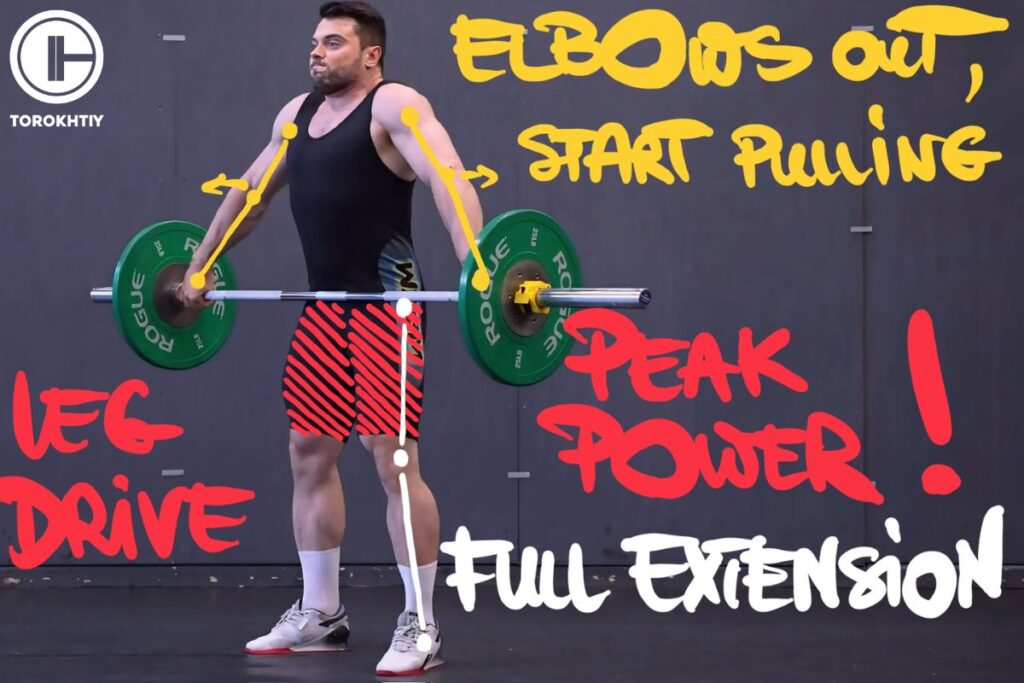
4. Extension
When you reach full extension, your shoulders should still be slightly over the bar and you should be on your toes because of the powerful extension of your knees and hips. Focus on keeping the bar close by driving the elbows up and out and aim to reach the highest point with the barbell. The key here is to concentrate on lifting your elbows as high as possible rather than on how high the bar is.
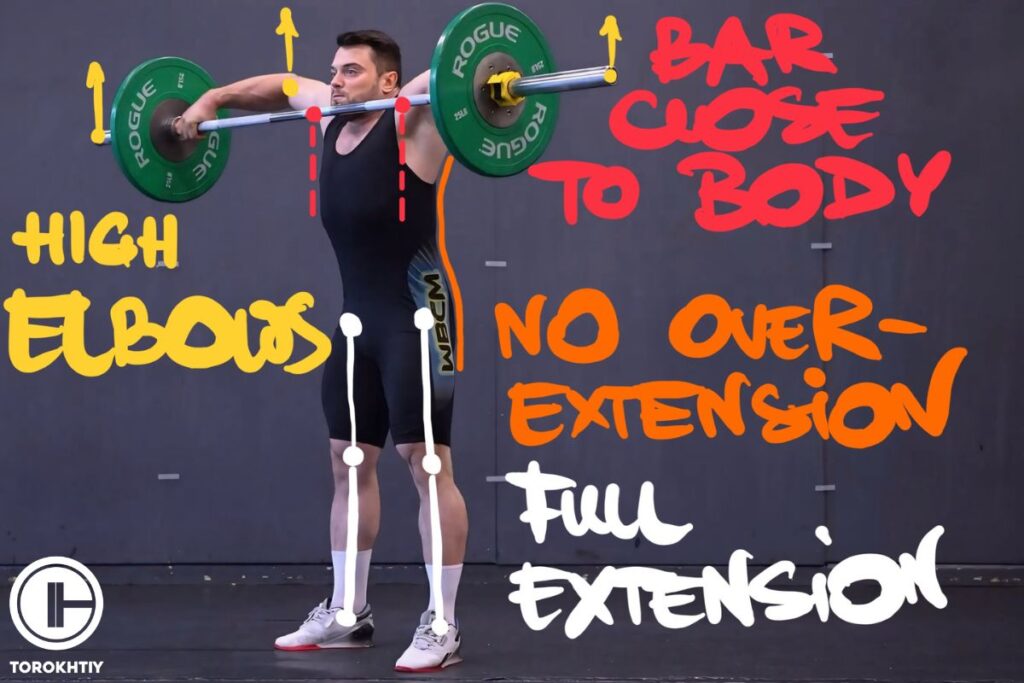
5. Lower the Barbell
Now all that’s left is to lower the barbell back down. This has to be controlled and smooth. Keep the bar close, bring it back down to your hips and then to th starting position.
How to Program Snatch High Pull?
Beginner
- Sets: 3-4 sets
- Reps: 3-5 reps per set
- Frequency: Do the snatch high pull 2 times a week
- Tips for Progression: Focus on mastering technique before increasing the weight. Use an empty barbell or very light weights to build confidence and learn the basics. Increase the weight in 5-pound increments as you progress.
Intermediate
- Sets: 4-5 sets
- Reps: 3-4 reps per set
- Frequency: Do the snatch high pull 2-3 times a week
- Tips for Progression: Start using heavier weights to build power while still maintaining technique. You can also vary the speed of the lift and incorporate both explosive pulls and slower, more controlled pulls. Consider adding tempo work to reinforce positions and control.
Advanced
- Sets: 5-6 sets
- Reps: 2-3 reps per set
- Frequency: Do the snatch high pull 3 times a week
- Tips for Progression: The focus should be on maximizing power output while maintaining flawless technique. Use weights close to your snatch maximum and include variations like high pulls from the hang or blocks to target different phases of the pull.
Save it for easy access!
Bookmark this page now to access the program and instructional videos anytime, anywhere.
Stop wasting time searching during your gym sessions.
Muscles Worked by the Snatch High Pull
The snatch high pull is a powerful exercise that targets many of your muscles. Let’s see what those are.
1. Quads
Your quads are heavily engaged during the first phase of the lift as you drive the bar off the ground. They’re responsible for extending the knees and providing the power needed to kick off the pull.
2. Hamstrings
The hamstrings help stabilize your lower body and assist with extending the hips during the pull. The help control the descent and maintain balance throughout the exercise.
3. Glutes
Glutes are activated during the hip extension and they generate a lot of power to help drive the bar up. Strong glutes are essential for achieving full extension and maximizing the height of the bar.
4. Traps
The traps are very involved during the second pull and the full extension. They help lift the shoulders and pull the elbows high, which is important for achieving the maximum height of the barbell.
5. Core
The core is what keeps your body stable during the snatch and pull. A strong core helps maintain balance and control, especially as you move through the different phases of the lift.
7. Forearms and Grip
Your forearms and grip are engaged during the entire time to hold onto the barbell securely. This is especially important as the weight increases and the bar moves rapidly.
4 Benefits of Snatch High Pull
The snatch high pull can improve your lifting ability and athletic performance. Here are some key benefits:
✅ Improved Explosive Power
This exercise helps you generate force quickly, which is crucial for powerful movements like the snatch.
✅ Better Snatch Technique
Because it focuses specifically on the pull phase, the snatch high pull helps you improve the technique needed for the full snatch. If you practice regularly, this can lead to a more efficient bar path and better timing.
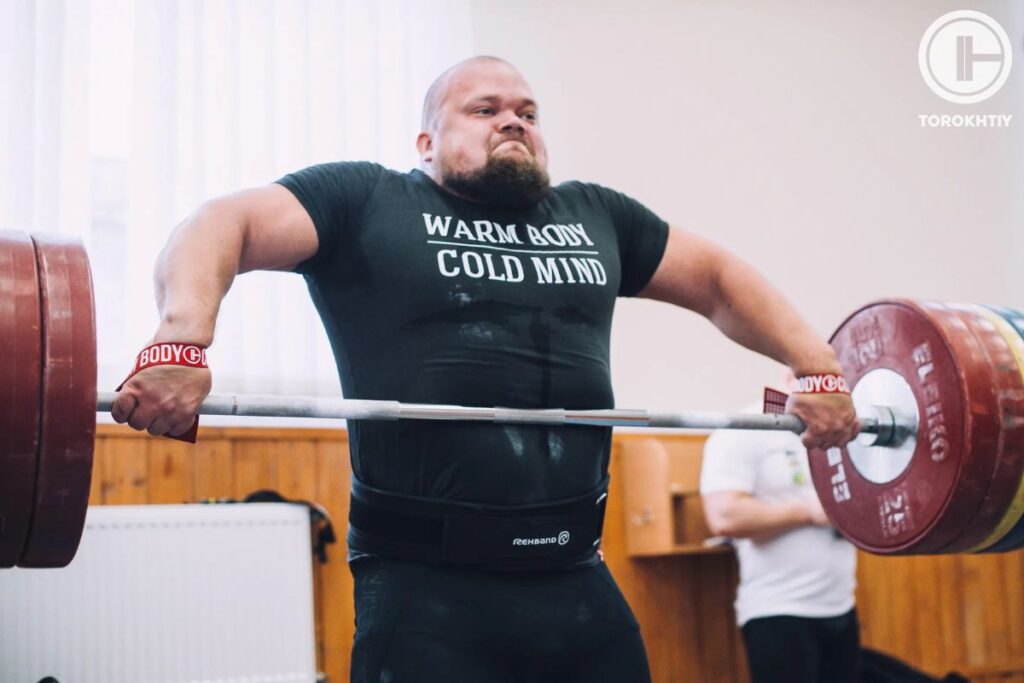
✅ Upper Body Strength
The snatch high pull works a lot fo the muscles in your upper body, and strengthening them will improve your performance in the Olympic lifts but also contribute to overall upper body strength. This can improve your performance in other lifts and sports.
✅ Enhanced Core Stability
Doing the snatch pull successfully needs a strong core or you’ll lose your balance. Over time, this exercise will make your core stronger and more stable, which will support the lift itself better, but also improve your balance and control in other exercises.
Follow us!

Free!
Get a 2-week Weightlifting Program as a bonus for the subscription to kickstart your training plan!

Free!
Who Should do the Snatch High Pull?
Any athlete that wants to increase squat snatch or be more explosive and strong should practice this drill. No matter your level of weightlifting proficiency, the snatch high pull is a versatile tool for moving forward.
1. For Initial Training
To learn the second pull path & positions, beginners in Olympic weightlifting should do the high snatch pull.
2. For Experienced Athletes
The lack of force in the second pull might restrict progress in snatch. That is why using this pull variation is important as for technical mastery as far as speed and power development.
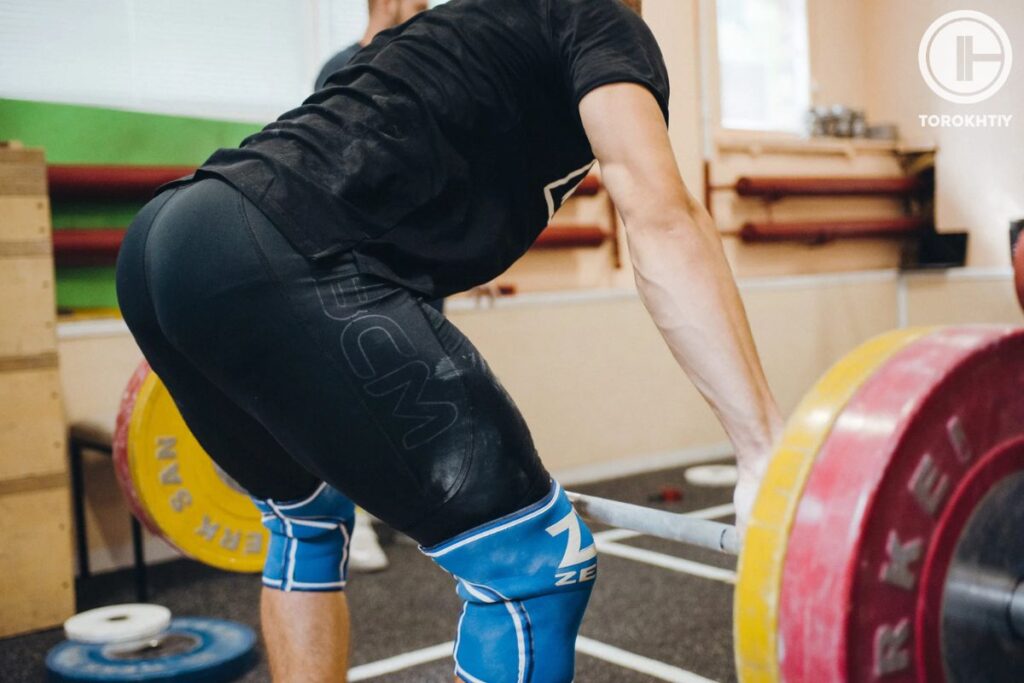
3. Athletes From Other Sports
For any track & field, basketball, tennis, or boxing athlete, strength training throughout the offseason is an essential component.
Squats and deadlifts are the basic exercises that all of these athletes perform, although the snatch high pull can address specific areas both squat and deadlift can’t. Neuromuscular efficiency, balance and coordination are few of what Snatch High Pull can improve well.
4. Fitness Athletes
In order to get ready for a weightlifting/snatch WOD, CF athletes should incorporate the high pull in their programs. In fitness, the goal of the snatch is often to squeeze the most reps into the quickest amount of time. Your WOD performance will be more effective and productive if you practice your snatch pull techniques.
4 Common Snatch High Pull Mistakes
The snatch high pull is very effective, but to get the most out of it, you need to do it properly. Here are some common mistakes to watch out for and how to avoid them.
❌ Rounding the Back
One of the most common mistakes, especially with beginners. Rounding the back can put unnecessary strain on your lower back and cause injury. To avoid it, keep your chest up, engage your core, and keep your spine neutral.
❌ Not Keeping the Bar Close
If you allow the barbell to drift away from your body, the lift won’t be as efficient and it will throw off your balance. Always focus on keeping the bar close to your body, almost brushing against your legs.
❌ Improper Elbow Position
Some lifters fail to drive their elbows high enough, which can limit the height of the pull. Concentrate on driving your elbows up and out during the pull to get maximum height and make sure you’re sticking to proper technique.
❌ Insufficient Hip and Knee Extension
If you don’t extend your hips and knees at the top of the lift, it will reduce the amount of power you generate and the exercise won’t be as effective. Make sure to drive through your legs and hips, coming onto your toes, to achieve full extension and maximize the explosive power of the movement.
6 Snatch High Pull Variations
You can experiment with starting positions of the snatch high-pull just for a change or in order to reach different goals.
1. The deficit snatch high-pull
An extended range of motion makes you “stand” the pull for a slightly longer time and improves acceleration skills. This exercise is crucial for athletes with a weak lower back who struggle to drive a bar off the platform or simply lack the strength and power to accelerate in the first pull.
The deficit variation toughens all muscles at the back of a body, especially legs and the lower back, improves the quality of efforts, and fixes the starting position. It is better to use this exercise during the preparation period when athletes are accruing resources to show a new result.
However, you should always remember that the recovery period after the deficit pulls is much longer than after the usual ones. As to the working loads, an athlete should be able to perform the exercise with the normal biomechanics and maintain high speed throughout the motion.
In case you can’t perform it correctly in terms of technique, make sure to reduce the load, otherwise, there is little use doing it. Good technique is what keeps you safe and it makes the exercise effective so make sure to always do everything properly.
It is also important to know that athletes with low mobility and flexibility might have a hard time setting up the right and safe starting position. In this case. a coach and an athlete should figure out whether it is possible to work this way. If yes, you can vary the height of a plate.
2. From blocks
A shorter range of motion allows you to fully concentrate on the quality of the second pull. It also makes it possible to involve arms even more and work on pointing elbows straightly upwards. It mainly benefits particular pull phases, especially the extension in the snatch and clean exercises.
By the way, always mind the safety while using blocks. In case an athlete isn’t attentive enough while lowering a barbell, it may fall on the edge of a block and bounce off anywhere causing damage or even injuries. Therefore, I recommend lowering the bar carefully.
3. From one block
This exercise has a short range of motion too but a block is placed between your legs. It creates slight barbell oscillations and thus helps an athlete maintain higher velocity and dynamics. It increases the training intensity as well as improves coordination and speed.
4. With a pause
Many functional athletes have a “sin” of overshrugging shoulders backwards and overextension in the second pull. While working on technique in the snatch high-pull, a 2-3-second pause at the knee level allows you to feel the feet balance, fix the legs and back positions, and relax the arms in order to speed up a barbell and do your best in the second pull.
5. The flat-footed variation
Any flat-footed pull is a coordination challenge even for top athletes. Holding tight throughout the whole range of motion while staying flat-footed is a sign of perfect muscle control and mastery. This exercise is especially helpful for those athletes who tend to rise up on their toes too soon or lose balance in the pull.
I recommend using 40-50% load for this exercise and performing it with a short range of motion: from one or two blocks or a high hang position. For implementing this skill in completion exercises, you can also perform a set of the flat-footed snatch high-pull and high snatch (i. e. the power snatch).
6. With slow lowering
Eccentric exercises are always beneficial: firstly, they boost TUT; secondly, improve technique and angles; thirdly, develop coordination due to the switch between a powerful upward movement and a slow downward one; fourthly, eccentric work strengthens back and legs muscles; and, finally, they train patience which is also extremely important.
As you can see, even the high-pull has plenty of variations.
3 Snatch High Pull Alternatives
If you want exercises that have similar benefits to the snatch high pull, we have a few excellent ones to share!
1. Clean High Pull
This one is done with a narrower grip and it involves pulling the bar up to chest height wile keeping it close to your body and driving through your legs and hips. It targets the same explosive power and pulling mechanics as the snatch high pull but it’s a bit more specific to the clean and jerk.
2. Snatch Deadlift
It mimics the first pull of the snatch and you do it with a wide grip. This exercise is an excellent alternative because it builds the foundational strength needed for the snatch, especially in the lower back, glutes, and hamstrings.
3. Snatch Pull
This is similar to the snatch high pull, but it focuses more on achieving full extension rather than pulling the elbows high. It’s a direct alternative that helps reinforce the explosive nature of the snatch without the added complexity of the catch.
Conclusion
And that’s all on the snatch high pull! It’s a versatile exercise that’s good for athletes across various sports, not just Olympic weightlifters. It improves speed, power, coordination, posture, so any training regimen can benefit from it. If you incorporate variations and take the time to learn the technique, you’ll significantly improve your snatch performance and overall explosive strength.
Keep at it, take some time to learn the ropes and you’re golden. Oh, and don’t forget to rest for a day or two because your muscles need it.
How has the snatch high pull impacted your training and performance? Which variation is your favorite and why? Do you use straps?
Share your thoughts in the comment section!
Also Read:
- Snatch From Blocks
- Snatch Pull
- Snatch Exercise
- Snatch Sots Press
- Snatch Push Press
- Split Snatch Exercise
- Muscle Snatch vs Power Snatch vs Snatch
- Hang Muscle Snatch Exercise
- Hang Snatch High Pull
- Snatch vs Clean & Jerk
References:
- Becks Shepherd “Why are rest days important?” LiveScience, https://www.livescience.com/why-are-rest-days-important (accessed July 22nd, 2024)
- Health Promotion Board (HPB) “Prevent Injuries with Proper Form During Workouts,” Singapore University Health Center, https://www.nus.edu.sg/uhc/articles/details/prevent-injuries-with-proper-form-during-workouts (accessed July 22nd 2024)
- Mayo Clinic Staff, “Weight training: Do’s and don’ts of proper technique,” Mayo Clinic, https://www.mayoclinic.org/healthy-lifestyle/fitness/in-depth/weight-training/art-20045842 (accessed July 22nd, 2024)
- Photos by Torokhtiy Media Team.
Why Trust Us?
With over 20 years in Olympic weightlifting, strength training, nutrition coaching, and general fitness our team does its best to provide the audience with ultimate support and meet the needs and requirements of advanced athletes and professional lifters, as well as people who strive to open new opportunities and develop their physical capabilities with us.
By trusting the recommendations of our certified experts in coaching, nutrition, and sports training programming, as well as scientific consultants, and physiotherapists, we provide you with thorough, well-considered, and scientifically proven content. All the information given in the articles concerning workout programming, separate exercises, and athletic performance, in general, is based on verified data.
The product testing process is described in more detail here.
Author: Jacek Szymanowski
Certified Nutritionist,
M.Sc.Eng. Biotechnology
Performance Architect,
Strength and Conditioning Specialist
With over 30 years of fighting experience, specialization in nutrition coaching for athletes, and expertise in metabolic health and dietary strategies, Jacek offers a comprehensive approach to optimizing your performance and well-being. Backed by a Master of Science degree in Biotechnology, Jacek remains at the forefront of scientific advancements, ensuring that his coaching is always evidence-based and up-to-date.
Reviewed by: Oleksiy Torokhtiy
Olympic Weightlifting Champion, PhD in Sport Science
Best Results: Snatch – 200 kg,
C&J – 240 kg
Oleksiy Torokhtiy is a professional athlete boasting 20 years of experience in Olympic weightlifting. With multiple European and World titles under his belt, he has showcased his prowess in two Olympic Games (Beijing 2008 and London 2012). Upon concluding his illustrious career, Oleksiy dedicated himself to coaching. By 2022, he had conducted over 200 weightlifting seminars worldwide. He is the visionary behind an international sportswear and accessories brand known for its motto, “Warm Body Cold Mind.” Additionally, he is an esteemed author and the creator of a series of training programs and eBooks.




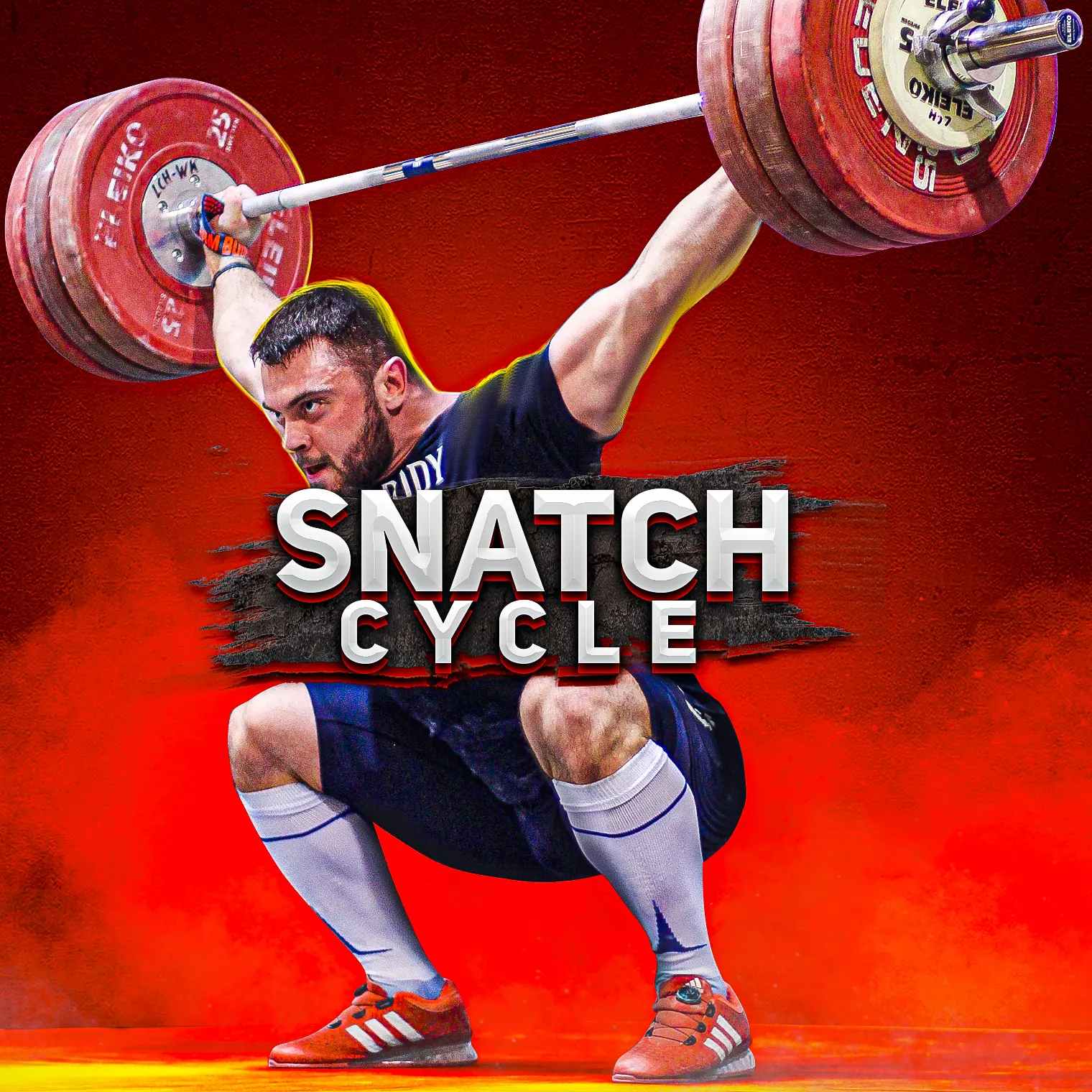
Still have questions after reading our article? Unlock your full potential by engaging with our experts and community! Don’t hesitate — leave a comment below and Jacek Szymanowski will provide a personalized answer and insights to help you reach your goals.